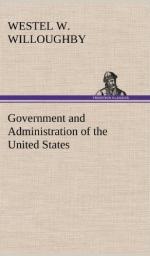Though the delegates had thus assembled to form a better and new union, they differed widely in their views as to what changes were necessary, and as to what powers should be given to the Federal Government, and what retained by the States. Some desired merely a change of the existing Articles of Confederation, more power being granted, however, to the Federal Government; while others wished for an entirely new Constitution.
The convention at once divided into two parties. The one representing the small States, such as New Jersey and Delaware; and the other, the larger States, such as Virginia, New York and Massachusetts. The plan brought forward by the party of the large States was that presented to the convention by Edmund Randolph, of Virginia, and generally known as the National or Large State Plan. This plan proposed a congress of two houses, having power to legislate on all National matters, and to compel obedience on the part of the States. Representation in both houses was to be based on population, thus giving to the larger, and more populous, States the control of both branches of the legislature; and, also, since by this scheme the president, executive officers, and judges were to be appointed by Congress, control of the whole administration of the new government.
On behalf of the small States, Patterson, of New Jersey, introduced what is called the New Jersey plan. By this plan the old Federal Congress was to be continued with its single house of legislature, and equal State vote.
The great point upon which the two plans differed, was as to how representation in the legislature should be apportioned among the States; whether it should be according to population, and with two houses, or whether there should be but one house, in which each State should have an equal vote. The question was settled by a compromise. It was agreed that there should be a legislature of two houses, a Senate or upper and less numerous branch; and the House of Representatives, the popular and more numerous lower branch. In the Senate each State was to have an equal representation, thus putting the large and small States on an equal footing. On the other hand, in the House of Representatives representation was to be according to population, thus favoring the larger States.
Another point upon which the convention differed was concerning the slave trade; whether it should, or should not, be allowed to continue. This question was also compromised, it being agreed to permit its continuance for twenty years (until 1808), after which all importation of slaves might be prohibited.
Yet another point in dispute was whether the slaves should, or should not, be counted in estimating the population of the States, in order to determine the number of representatives to which each State should be entitled. This likewise was compromised. It was agreed that five slaves should be counted equivalent to three white men.




